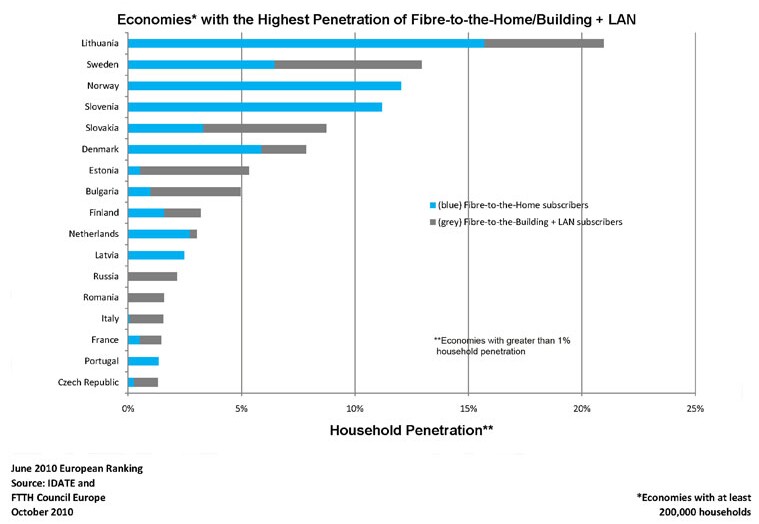Europe's New Member States continue to dominate the FTTH Rankings
Tuesday, October 26th, 2010
Three out of the top five fibre nations are recent members of the European Union; Romania enters the rankings
BRUSSELS — The number of fibre-to-the-home subscribers in Europe, including Russia, has increased by 22% over the past six months, thanks to the booming broadband market in the Eastern part of Europe, according to the latest figures from the FTTH Council Europe, which were announced today at the Broadband World Forum in Paris.
In absolute numbers, Europe has reached 3.2 million FTTH/B subscribers (nearly 4.5 million including Russia). And network deployment continues to bring fibre within reach of more homes: Europe now counts 18 million FTTH/B homes passed (more than 26 million including Russia), a growth of more than 6% during the first half of 2010.
The FTTH Ranking now includes 17 countries in Europe where more than 1% of households subscribe to broadband over a direct fibre connection. Lithuania is still the leader in the Ranking, just ahead of the more mature FTTH markets of Sweden and Norway. Notice that the top five fibre nations now include three New European Member States: Lithuania, Slovenia and Slovakia.
There was one new entrant – Romania – which enters the Ranking in 13th place with more than 120,000 FTTH/B subscribers. Bulgaria shows the fastest progression in the Ranking, moving from 16th to 8th position during first half of 2010, and increasing penetration by 4 percentage points. And Lithuania, still in first place, showed the second fastest growth rate, boosting subscriber penetration by 3.3 percentage points.
“With Romania joining the Ranking, Bulgaria and Lithuania making such rapid progress as well as three other countries (Slovenia, Estonia, Latvia) increasing penetration by more than 1%, the New Member States are leading the drive for fibre to the home in Europe,” said Chris Holden, President of the FTTH Council Europe. “If we include Russia, today the majority of FTTH/B connections are found in the Eastern part of Europe.”
Jan Schindler, Chair of the Market Intelligence Committee at the FTTH Council Europe, explains some of these findings. “The deployment of first-generation broadband over copper was less extensive in many New Member States, creating an unmet demand for competitively-priced Internet connectivity. Hundreds of smaller local service providers are springing up to take advantage of the opportunity.”
Penetration Penetration
FTTH/B subs in total HH FTTH/B subs in total HH
Countries June 2010 June 2010 Countries June 2010 June 2010
----------- ----------- ----------- -----------
1 Lithuania 284,400 20.96% 10 Netherlands 211,500 3.02%
2 Sweden 569,000 12.93% 11 Latvia 22,200 2.48%
3 Norway 240,689 12.03% 12 Russia 1,200,000 2.15%
4 Slovenia 75,000 11.19% 13 Romania 120,000 1.58%
5 Slovakia 192,000 8.73% 14 Italy 347,000 1.56%
6 Denmark 195,900 7.84% 15 France 371,312 1.46%
7 Estonia 31,000 5.33% 16 Portugal 52,500 1.35%
8 Bulgaria 144,000 4.97% 17 Czech Republic 50,000 1.32%
9 Finland 79,390 3.21%

The majority of FTTH subscribers (74%) are concentrated in eight countries, in the following order: Sweden, France, Italy, Lithuania, Norway, The Netherlands, Denmark and Slovakia. Amongst them, six countries can boast more than 200,000 subscribers – and Denmark as well as Slovakia are getting close.
Major European economies such as Italy and France are still at the bottom of the Ranking, and others such as Britain, Germany and Spain are noticeably absent, although co-investment between operators and national plans initiated by governments could soon start to enhance FTTH/B coverage in those nations.
The FTTH Council Europe’s unique Ranking is part of its Market Panorama study, carried out for the Council by research firm IDATE. The Panorama shows the percentage of homes and small businesses in each country that receive broadband communications services over direct fibre”optic connections.
The complete Global Ranking for 2010, which also incorporates data from the FTTH Councils of Asia-Pacific and North America, will be announced at the European FTTH Conference, to be held in Milan, Italy, on 9 & 10 February 2011.
Note: The FTTH Global Ranking is based on the definition of FTTH/B agreed by the three FTTH Councils. It includes fibre to the home (FTTH), where the fibre connection reaches the household, and fibre to the building (FTTB), where fibre terminates inside the boundary of a multi-tenant building. The Ranking covers all countries with at least 200,000 households where the penetration of FTTH/B has reached at least 1% of the total number of homes.
Latest News
- Barb to start reporting TV-set viewing of YouTube channels
- SAT FILM selects multi-DRM from CryptoGuard
- Qvest and ARABSAT to launch OTT streaming platform
- ArabyAds & LG Ad Solutions partner with TVekstra in Turkey
- Freeview NZ satellite TV service to move to Koreasat 6
- Comscore expands YouTube CTV measurement internationally
